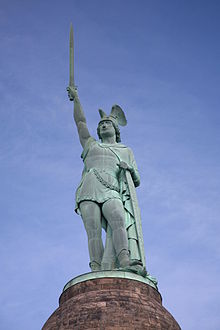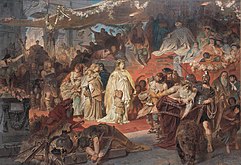3. 참패의 결말 ¶
4. 뒷이야기 ¶
============================================================================
Arminius
아르미니우스[Arminius]
(18/17 BC – 21 AD)

Hermannsdenkmal memorial

No known portrait image of Arminius exists from his life. This likeness was created by artist and historian George S. Stuart from physical descriptions mentioned in historical records.
게르만의 영웅으로, 독일에서는 게르만의 해방자라고 하며 그를 존경한다. 아르미니우스(Arminius)는 로마식으로 표기된 이름이며, 언어에 따라 아르민(Armin)또는 헤르만(Hermann)으로 표기되기도 한다.

This Roman sculpture of a young man is sometimes identified as Arminius

Varusschlacht, Otto Albert Koch (1909)

Arminius says goodbye to Thusnelda, Johannes Gehrts (1884)
===========================================================================
투스넬다(Thusnelda)
(c. 10 BC – unknown)

Thusnelda statue in Loggia dei Lanzi, Florence.
그녀와 결혼할 것을 청했다.[Germanic Cheruscan noblewoman who was captured by the Roman general Germanicus during his invasion of Germania. She was the wife of Arminius. Tacitus and Strabo cite her capture as evidence of both the firmness and restraint of Roman arms.]

Thusnelda at the Triumph of Germanicus, by Karl von Piloty, 1873

Thusnelda at the Triumph of Germanicus, by Karl von Piloty, 1873
서기 17년 케루스키족과 그 동맹군들에게 승리를 거둔 게르마니쿠스는 로마에서 화려한 개선식을 하였다.이때 로마 군대가 사로잡은 아르미니우스의 아내 투스넬다가 다른 포로들과 함께 개선식에 끌려 나왔고 이 그림이 그 장면을 그린 것이다. 이 그림에서 투스넬다는 마치 여왕처럼 당당하고 위엄있는 모습이며 로마인들은 황제조차도 우울해 보이며주변의 인물들은 음울하면서도 퇴폐적인 분위기로 그려 놓았다. 그림의 이러한 표현 방식은 독일이 프랑스와의 전쟁(1870)에서 승리한 후 국가적인 자긍심이 한껏 높아진 빌헬름 황제 시대를 반영한 듯 하다.
이 그림을 그린 Karl Thedor von Piloty는 독일 뮌헨에서 태어나 뮌헨에서 수학했으며 후에 뮌헨 아카데미 교수와 학장을 역임했고 역사화를 많이 그린 화가로 알려져 있다.
[Thusnelda was the daughter of the pro-Roman Cheruscan prince Segestes. In 9 AD, Arminius, Thusnelda's future husband, who had been given by his father to the Romans as a child and raised as a Roman military commander serving under Publius Quinctilius Varus, switched sides to the Germans, and led a coalition of Germanic tribes that defeated the legions of Varus at the Battle of the Teutoburg Forest. The conflict between the Roman Empire and the Germanic tribes continued after the Battle of the Teutoburg Forest, and Arminius abducted and impregnated Thusnelda circa 14 AD, likely as a result of a dispute with her pro-Roman father.[1]
In May 15 AD, Thusnelda was captured by Germanicus, who commanded the invasion of Germania. She was pregnant and staying with her father, who had seized her from Arminius at some point. It was Segestes who delivered her to Germanicus, after the latter saved the former by driving off Arminius' forces, who had besieged Segestes.[2] Arminius grieved his loss of Thusnelda deeply and did not marry again.[3] According to Tacitus, Arminius was "driven to frenzy" by the loss of his wife.[4][5]
During her captivity, Thusnelda gave birth to her and Arminius' only child, Thumelicus. At the Battle of the Weser River, Arminius engaged in a famous disputation with his brother Flavus, who was still serving in the Roman army. Flavus informed Arminius that Thusnelda was being well-treated — as, he claimed, was typical of Rome. On May 26, 17 AD, Thusnelda and her son Thumelicus were displayed as prized trophies of the triumph granted to Germanicus. During the triumphal parade, her father was forced to watch from the stands.[6] Contemporary historians evince discomfort with her display as evidence of Roman victory in Germania, as Arminius had resisted capture.[7]
Thusnelda's son, Thumelicus, was trained at the gladiator school in Ravenna and is believed to have died in a gladiator show at a young age. Tacitus wrote that he would report on Thumelicus' fate "at the proper time" — i.e., when he discussed the year in question in his chronicle.[8] The main gap in the text of the Annals is for 30 and 31 AD, so it could be that Thumelicus died then, aged 15 or 16.
Details of Thusnelda's life after the triumph of 17 AD and her date of death are unknown.



